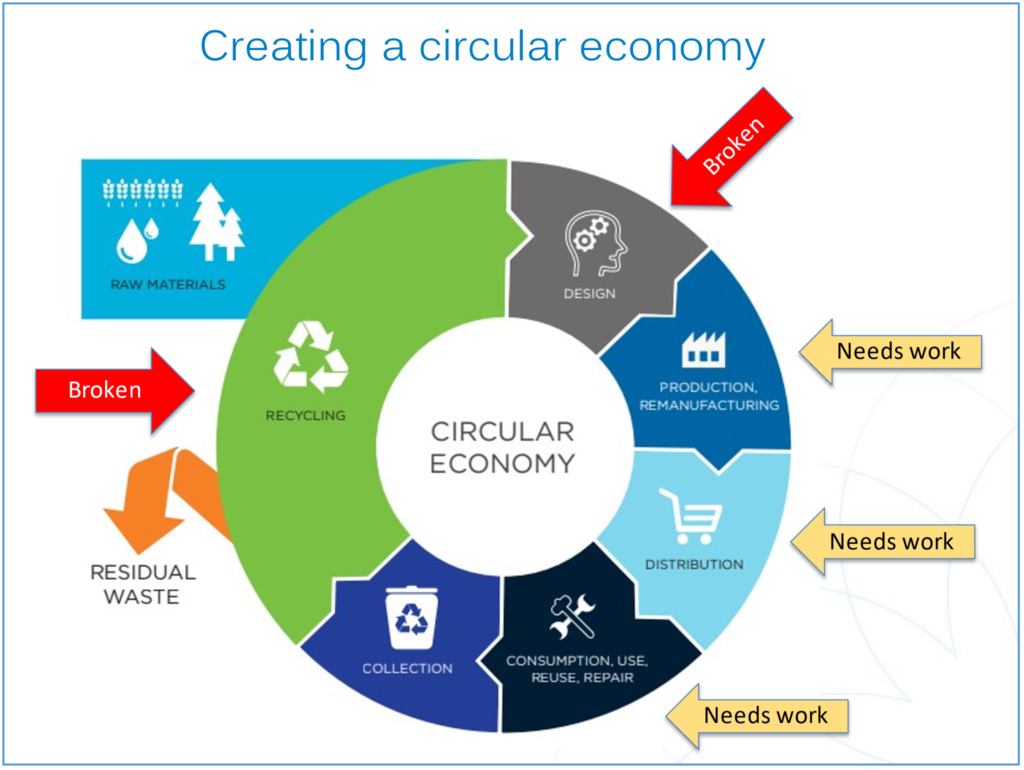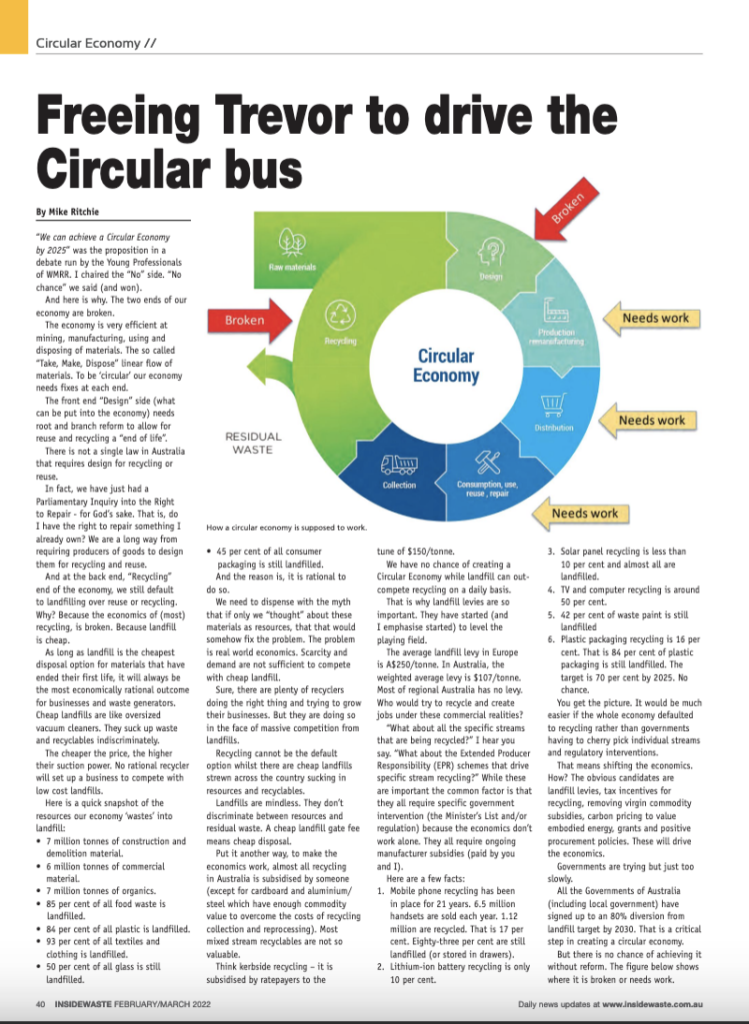Freeing Trevor to drive the circular bus
By: Mike Ritchie, MRA Consulting Group

And here is why.
The two ends of our economy are broken.
The economy is very efficient at mining, manufacturing, using and disposing of materials. The so called “Take, Make, Dispose” linear flow of materials.
To be ‘circular’ our economy needs fixes at each end.
The front end “Design” side (what can be put into the economy) needs root and branch reform to allow for reuse and recycling at “end of life”.
There is not a single law in Australia that requires design for recycling or reuse. In fact, we have just had a Parliamentary Inquiry into the Right to Repair – for God’s sake. That is, do I have the right to repair something I already own.
Tweet
We are a LONG way from requiring producers of goods to design them for recycling and reuse.
And at the back end “Recycling” end of the economy, we still default to landfilling over reuse or recycling. Why? Because the economics of (most) recycling, is broken. Because landfill is cheap.
As long as landfill is the cheapest disposal option for materials that have ended their first life, it will always be the most economically rational outcome for businesses and waste generators. Cheap landfills are like oversized vacuum cleaners. They suck up waste and recyclables indiscriminately.
The cheaper the price, the higher their suction power. No rational recycler will set up a business to compete with low cost landfills.
Here is a quick snapshot of the resources our economy ‘wastes’ into landfill:
- 7 million tonnes of construction and demolition material
- 6 million tonnes of commercial material
- 7 million tonnes of organics
- 85% of all food waste is landfilled
- 84% of all plastic is landfilled
- 93% of all textiles and clothing is landfilled
- 50% of all glass is still landfilled
- 45% of all consumer packaging is still landfilled
And the reason is, it is rational to do so.
We need to dispense with the myth that if only we “thought” about these materials as resources, that that would somehow fix the problem. The problem is real world economics. Scarcity and demand are not sufficient to compete with cheap landfill.
Sure, there are plenty of recyclers doing the right thing and trying to grow their businesses. But they are doing so in the face of massive competition from landfills.
Recycling cannot be the default option whilst there are cheap landfills strewn across the country sucking in resources and recyclables.
Landfills are mindless. They don’t discriminate between resources and residual waste. A cheap landfill gate fee means cheap disposal.
Put it another way, to make the economics work, almost all recycling in Australia is subsidised by someone (except for cardboard and aluminium/steel which have enough commodity value to overcome the costs of recycling collection and reprocessing). Most mixed stream recyclables are not so valuable.
Think kerbside recycling – it is subsidised by ratepayers to the tune of $150/t.
We have no chance of creating a Circular Economy while landfill can outcompete recycling on a daily basis.
That is why landfill levies are so important. They have started (and I emphasise started) to level the playing field.
The average landfill levy in Europe is A$250/t. In Australia, the weighted average levy is $107/t. Most of regional Australia has no levy. Who would try to recycle and create jobs under these commercial realities?
“What about all the specific streams that are being recycled?” I hear you say. “What about the Extended Producer Responsibility (EPR) schemes that drive specific stream recycling?” While these are important the common factor is that they all require specific government intervention (the Minister’s List and/or regulation) because the economics don’t work alone. They all require ongoing manufacturer subsidies (paid by you and I).
Here are a few facts:
- Mobile phone recycling has been in place for 21 years. 6.5 million handsets are sold each year. 1.12 million are recycled. That is 17%. 83% are still landfilled (or stored in drawers)
- Lithium-ion battery recycling is only 10%
- Solar panel recycling is less than 10% and almost all are landfilled
- TV and computer recycling is around 50%
- 42% of waste paint is still landfilled
- Plastic packaging recycling is 16%. That is 84% of plastic packaging is still landfilled. The target is 70% by 2025. No chance.
You get the picture. It would be much easier if the whole economy defaulted to recycling rather than governments having to cherry pick individual streams and regulatory interventions.
That means shifting the economics. How? The obvious candidates are landfill levies, tax incentives for recycling, removing virgin commodity subsidies, carbon pricing to value embodied energy, grants and positive procurement policies. These will drive the economics.
Governments are trying but just too slowly.
All the Governments of Australia (including local government) have signed up to an 80% diversion from landfill target by 2030. That is a critical step in creating a circular economy.
But there is no chance of achieving it without reform. The figure above shows where it is broken or needs work.
The key drivers of a Circular Economy are not going to mysteriously invent themselves. The economy is a political creation, so is circularising it.
Here is a list of the key framework (structural) changes that are “must haves” if we are going to make any headway. Some are easy but most require political intervention and courage.
Design end of the economy:
- Design for reuse and recycling rules including bans on composite packaging (for example plastic inserts in envelopes, plastic windows in paper bread bags, banning PVC drink containers, bans on those ridiculous plastic fruit stickers etc)
- Recycling labelling rules on all products sold in the economy
- Recycled content rules (incl. minimum levels)
- Extended Producer Responsibility regulated schemes for difficult to collect materials (e.g. mattresses, solar panels, tyres, batteries, fire alarms etc)
At the back end of the economy:
- Market reform – levies, taxes, subsidies, carbon pricing and grants.
- Specifically minimum landfill levies across Australia to drive materials to recycling rather than cheap holes in the ground
- Hypothecation of levy funds to collection and recovery systems (firstly organics)
- Bans on materials to landfill (firstly organics which in landfill currently generates a significant portions of Australia’s anthropogenic methane emissions)
- Government procurement rules to drive recycling markets
- Government planning policies to allow recycling facilities to be built and not be built out
- Supply chain incentives to drive waste avoidance (will partly happen as recycling becomes cheaper relative to landfill)
But we need to face a few realities. Circular Economy will be more expensive in the short term than a “take, make, dispose” economy. Almost all recycling in Australia is currently more expensive than landfill (particularly underpriced or “free” landfills). Governments need to remedy that.
If we (the voting public) are serious about a Circular Economy we MUST give governments the freedom to change the economics of recycling. We know HOW to do it. But it requires governments to intervene in the market. That means politics.
The leaders we need right now, are Trevor Evans (Federal Minister for Recycling and Waste Minimisation; first one ever) and State Environment Ministers, many of whom are convinced of the need but don’t have the political mandate to shift the Circular Economy dial.
As voters and advocates we need to give them the political capital to do so. That means convincing our peers that reform is needed, supporting changes to the economics when it occurs (e.g. levies) and most importantly supporting political bravery to encourage more and faster action.
There is no chance we can achieve a Circular Economy by 2025, but achieving the 80% diversion from landfill Target in the National Waste Action plan by 2030, is achievable and we must support it.
Trevor and the State Ministers have given us the Plan. We need to allow (and push) them to drive the bus to achieve it.
Mike Ritchie, is the Managing Director at MRA Consulting Group.
This article has been published by the following media outlets:




